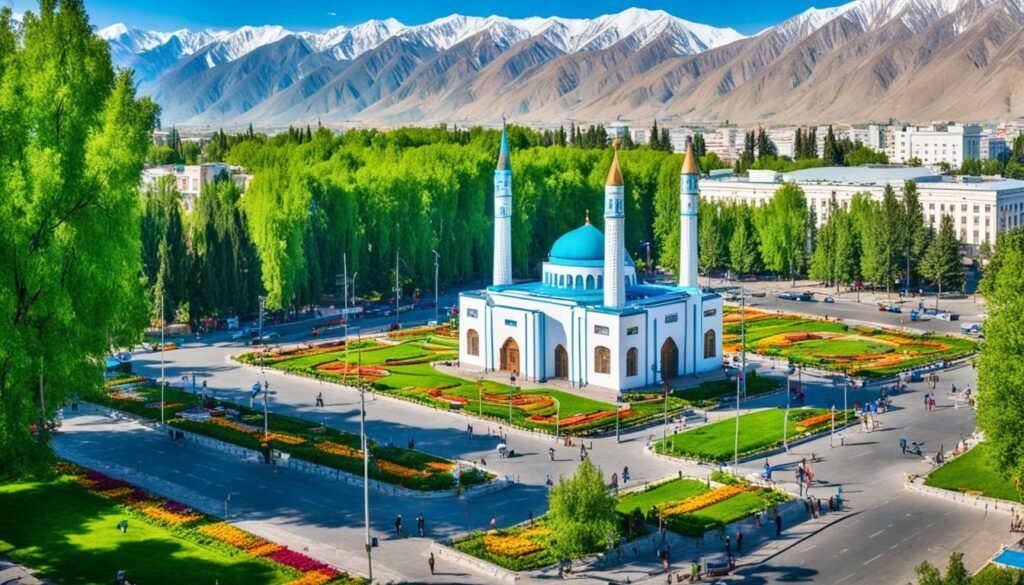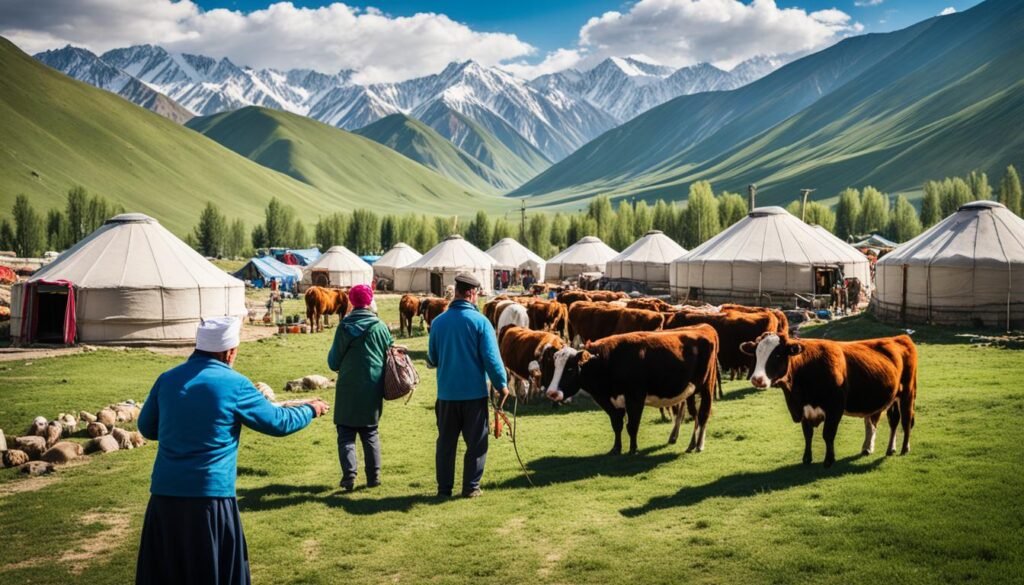Imagine a land where nomadic traditions have endured for centuries, where the vast, rugged landscapes of Central Asia meet the dynamic pulse of an urban center. Welcome to Kyrgyzstan, a small country that has captured the attention of cultural anthropologists and adventure-seekers alike. With a staggering 94% of its territory covered in mountains, Kyrgyzstan is a haven for those seeking to immerse themselves in the captivating tapestry of nomadic life.
Nestled within this majestic setting is Bishkek, the capital city of Kyrgyzstan, where the echoes of the past and the vibrant present coexist in a harmonious dance. As a gateway to the country’s rich nomadic heritage, Bishkek offers a unique opportunity to explore the interplay between traditional Kyrgyz lifestyles and the modern urban landscape.
Key Takeaways
- Kyrgyzstan is a small Central Asian republic known for its vibrant nomadic culture and stunning mountainous terrain.
- The capital city of Bishkek serves as a gateway to Kyrgyzstan’s rich nomadic heritage, blending traditional lifestyles with modern urban dynamics.
- Cultural anthropologists and adventure-seekers are drawn to Kyrgyzstan to immerse themselves in the captivating tapestry of nomadic life.
- Kyrgyzstan’s nomadic roots are deeply rooted in its Silk Road history and semi-nomadic pastoralism traditions.
- Exploring Kyrgyzstan’s nomadic culture and Bishkek’s urban environment offers a unique opportunity to understand the country’s cultural diversity and ethnic traditions.
Introduction to Nomadic Culture in Kyrgyzstan
Kyrgyzstan’s rich heritage is deeply rooted in its nomadic culture. For centuries, the Kyrgyz people were transhumant pastoralists, moving seasonally with their livestock across the vast Central Asian steppe. This nomadic lifestyle shaped the country’s cultural traditions, architectural styles, and economic practices.
Overview of Kyrgyzstan’s Nomadic Heritage
The Turkic ethnic groups that inhabited Kyrgyzstan were experts in transhumant pastoralism, utilizing the region’s diverse landscapes to sustain their herds of sheep, horses, and other livestock. The iconic yurt, a portable felt-covered dwelling, became a symbol of their nomadic culture, providing shelter as they traversed the Kyrgyzstan heritage.
Significance of Studying Nomadic Traditions
Understanding Kyrgyzstan’s nomadic culture is crucial for gaining insight into the country’s unique blend of ethnic diversity, language, and economic practices. By exploring the traditions and lifeways of these Central Asian nomads, researchers can uncover valuable insights into the region’s history, social structures, and environmental adaptations.
Bishkek: The Gateway to Kyrgyz Nomadism
Bishkek, the capital of Kyrgyzstan, serves as a captivating gateway to the country’s rich nomadic heritage. This vibrant city seamlessly blends its Soviet-era architectural legacy with modern development, reflecting the dynamic interplay between Kyrgyzstan’s traditional nomadic culture and its ongoing journey towards urbanization.
Navigating Bishkek’s meticulously planned grid-like layout, one can’t help but notice the influence of Soviet urban design. Yet, scattered throughout the city, remnants of the Silk Road’s legacy can be found, hinting at the centuries-old nomadic trade routes that once crisscrossed the region. This unique fusion of architectural styles, from brutalist structures to sleek contemporary buildings, tells the story of Kyrgyzstan’s modernization and its deep-rooted connection to its nomadic past.

Exploring Bishkek’s cultural landmarks, such as the iconic Ala-Too Square and the striking White House, provides insights into the country’s ongoing urban development. These sites serve as vibrant hubs where the echoes of Kyrgyzstan’s nomadic heritage seamlessly intertwine with the pulse of modern life, offering visitors a captivating glimpse into the country’s dynamic transformation.
Legendary Burana Tower: A Silk Road Remnant
Nestled in the heart of Kyrgyzstan’s captivating landscape, the Burana Tower stands as a remarkable testament to the country’s rich Silk Road history. This 45-meter brick tower, a reconstructed remnant of an ancient minaret, was once an integral part of a thriving Silk Road town. The tower’s striking Turkic architecture and the nearby ancient Turkic funeral monuments offer valuable insights into the region’s cultural heritage and the enduring influence of early Turkic civilizations.
History and Architecture of Burana Tower
The Burana Tower is a captivating relic of Kyrgyzstan’s Silk Road past. Constructed in the 11th century, the tower was once part of a larger complex that included a citadel, caravanserai, and a market. The tower’s distinctive tapered design and intricate brick patterns reflect the sophisticated Turkic architectural style that flourished along the ancient trade routes. Today, the Burana Tower stands as an iconic symbol of Kyrgyzstan’s archaeological and cultural significance, drawing visitors from around the world to explore its rich history.

Ancient Turkic Funeral Monuments
Surrounding the Burana Tower, visitors can discover a remarkable collection of ancient Turkic funeral monuments, known as Balbals. These stone sculptures, carved in the likeness of human figures, offer a glimpse into the beliefs and burial practices of the region’s early Turkic inhabitants. These archaeological sites provide valuable insights into the Kyrgyz cultural heritage and the enduring influence of Turkic traditions in the area.
Issyk Kul: Experiencing the Nomadic Lifestyle
Nestled in the heart of Kyrgyzstan, Issyk Kul lake offers a remarkable opportunity to immerse oneself in the country’s celebrated nomadic culture. This expansive alpine lake, the second-highest in the world, serves as a scenic backdrop for traditional yurt camps and the semi-nomadic communities that continue to thrive in the region.
Camping on the Shores of Issyk Kul Lake
Pitching a tent on the shores of Issyk Kul lake allows visitors to experience the tranquility and natural beauty that have long attracted nomadic herders to this enchanting locale. The serene waters and dramatic mountain vistas provide a serene setting for outdoor recreation, from hiking and horseback riding to kayaking and birdwatching.

Interacting with Local Nomadic Communities
Engaging with the local nomadic communities around Issyk Kul lake offers a unique chance to learn about their enduring traditions and way of life. Visitors can explore the vibrant semi-nomadic villages, attend cultural events, and witness the timeless practices of livestock herding, traditional craftsmanship, and Kyrgyz hospitality that continue to shape the region’s identity.
Kyrgyzstan: Nomadic culture studies Bishkek Kyrgyzstan
Kyrgyzstan’s capital, Bishkek, serves as a compelling case study for understanding the interplay between the country’s rich nomadic heritage and its ongoing modernization. The city’s urban landscape reflects the dynamic fusion of traditional nomadic lifestyles and the forces of urbanization, offering insights into how Kyrgyzstan’s nomadic past continues to shape its cultural identity and societal transformations.
As Bishkek has evolved, the city’s architecture showcases a blend of Soviet-era structures and contemporary buildings, symbolizing the tension between Kyrgyzstan’s nomadic culture and its embrace of urban studies and cultural fusion. Exploring Bishkek’s streets and neighborhoods provides a unique opportunity to witness the ways in which modernization trends have influenced the country’s nomadic traditions, while also preserving its cultural essence.

Through the lens of urban studies, one can observe how Kyrgyzstan’s nomadic culture has adapted to the demands of a modernizing society. The coexistence of traditional yurt dwellings and high-rise buildings, the fusion of ancient crafts and contemporary industries, and the intermingling of nomadic and urban lifestyles all contribute to Bishkek’s vibrant and multifaceted character.
By delving into Bishkek’s urban landscape, researchers and visitors alike can gain a deeper understanding of the complex interplay between Kyrgyzstan’s nomadic heritage and its ongoing societal transformations. This dynamic interplay offers a fascinating glimpse into the ways in which ancient traditions and modern influences converge, shaping the cultural fabric of this remarkable Central Asian nation.
Jeti-Oguz: The Seven Bulls and Nomadic Hospitality
In the heart of Kyrgyzstan’s breathtaking mountain landscapes lies the Jeti-Oguz region, renowned for its iconic “Seven Bulls” rock formations. This awe-inspiring natural wonder serves as a gateway to the country’s enduring nomadic culture and traditions.
Hiking to the Jeti-Oguz Rock Formations
Embarking on a journey through the Jeti-Oguz valley, visitors are treated to a stunning display of towering, rust-hued cliffs, sculpted by the elements over centuries. The hike to the iconic rock formations is both exhilarating and rewarding, offering panoramic vistas of the surrounding mountain landscapes.
Encountering Nomadic Summer Camps (Jailoos)
As travelers explore the Jeti-Oguz region, they may come across traditional nomadic summer camps, known as “jailoos.” These seasonal settlements showcase the Kyrgyz people’s deep-rooted connection to the land and their pastoral way of life. Visitors have the opportunity to witness the setting up of colorful yurts, the tending of livestock, and the warm hospitality of the nomadic communities that call these mountain landscapes home.
The Jeti-Oguz region offers a unique window into the enduring cultural heritage of Kyrgyzstan, where the majestic natural beauty is seamlessly intertwined with the vibrant nomadic traditions that have persisted for generations. This captivating destination invites travelers to immerse themselves in the outdoor activities and Kyrgyz hospitality that define the heart of the country’s nomadic legacy.
Ethnic Diversity and Languages in Kyrgyzstan
Kyrgyzstan is a tapestry of cultural richness, boasting a diverse array of ethnic groups and linguistic traditions. The Kyrgyz people, the largest ethnic group, are joined by significant minorities of Uzbeks, Russians, Ukrainians, and other Central Asian ethnicities, creating a captivating mosaic of identities.
This ethnic diversity is mirrored in the country’s linguistic landscape, where Kyrgyz, Russian, and various Turkic languages take center stage. The legacy of Soviet-era resettlement policies and the dynamics of the post-independence era have further shaped the demographic and linguistic makeup of this remarkable nation.
Navigating the intricate cultural and linguistic terrain of Kyrgyzstan is a dynamic and enlightening experience. From the Turkic-influenced Kyrgyz language to the continued presence of Russian, the country’s linguistic diversity reflects its unique history and the vibrant exchange of ideas across Central Asia.
As visitors delve into the richness of Kyrgyzstan’s ethnic and linguistic tapestry, they gain a deeper understanding of the country’s resilience and the enduring traditions that have shaped its identity. This cultural mosaic serves as a testament to the resilience and adaptability of the Kyrgyz people, inviting travelers to immerse themselves in the captivating world of this remarkable Central Asian nation.
Nomadic Economic Traditions: Agriculture and Crafts
Kyrgyzstan’s rich nomadic heritage is deeply reflected in its economic traditions and practices. At the heart of the country’s agricultural sector lies the enduring practice of livestock raising and semi-nomadic pastoralism. Sheep, goats, and horses play a central role, as Kyrgyz communities have long relied on these animals as a source of sustenance, transportation, and livelihood.
Livestock Raising and Pastoralism
Pastoralism, the practice of moving livestock between seasonal grazing grounds, remains an integral part of Kyrgyzstan’s nomadic economy. Herders skillfully navigate the rugged terrain, leading their flocks to high-altitude summer pastures (known as jailoos) and lower-lying winter encampments. This seasonal migration allows the land to regenerate, ensuring a sustainable balance between the nomadic communities and their natural environment.
Traditional Kyrgyz Handicrafts and Industries
Alongside its agricultural traditions, Kyrgyzstan boasts a rich history of craftsmanship. The Kyrgyz people have long produced a variety of handmade goods, including intricate textiles, exquisite leather products, and other artisanal items. These traditional industries not only sustain the livelihoods of Kyrgyz communities but also contribute to the preservation of the country’s cultural heritage. Visitors can immerse themselves in the vibrant world of Kyrgyz handicrafts, from the colorful felt carpets known as shyrdaks to the intricately carved wooden items that echo the nomadic lifestyle.
Kyrgyzstan’s nomadic economic traditions, encompassing both livestock farming and artisanal crafts, continue to shape the country’s identity and reinforce its deep connection to the past. These practices not only sustain the livelihoods of Kyrgyz communities but also serve as a testament to the enduring resilience and adaptability of the nomadic way of life.
Conclusion
Kyrgyzstan’s cultural heritage and nomadic traditions remain a defining aspect of the country’s identity. From the architectural wonders of the Silk Road to the vibrant nomadic communities thriving in the mountainous regions, Kyrgyzstan offers a unique opportunity to explore the dynamic interplay between traditional lifestyles and modern urban development.
By delving into the study of Kyrgyzstan’s nomadic culture, we gain invaluable insights into the region’s rich cultural tapestry and the resilience of these ancient traditions. As the country navigates the challenges of social, economic, and political transformations, the enduring presence of nomadic practices and the harmonious urban-rural dynamics in Kyrgyzstan serve as a testament to the resilience and adaptability of its people.
Exploring the Central Asia studies of Kyrgyzstan’s nomadic heritage not only deepens our understanding of the region’s cultural legacy but also highlights the importance of preserving and celebrating the essence of Kyrgyzstan’s cultural identity in the face of modernization. By embracing this rich tapestry of nomadic traditions, we can collectively work towards a future that honors the past while embracing the transformative potential of the present.
Source Links
- Kyrgyzstan – Nomadic, Ethnic Groups, Culture – https://www.britannica.com/place/Kyrgyzstan/People
- Kyrgyzstan where Turkic nomadic culture still lives – https://www.dailysabah.com/travel/2017/08/19/kyrgyzstan-where-turkic-nomadic-culture-still-lives
- Bishkek: Central Asian Studies – https://sras.heiapply.com/catalog/programs/1295


